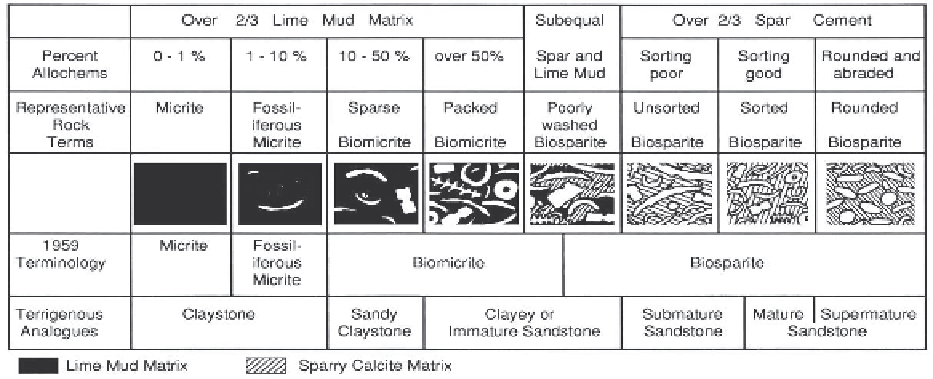Geology Reference
In-Depth Information
Fig. 8.6.
Concept and textural spectrum of the Folk classification
. Modified from Folk (1962). Note the increasing textural
maturity from left to right. Dismicrite is omitted in this figure.
base, or possible tectonic uplift'. Ooids are the next
important group, followed by fossils and peloids. This
ranking implies the
knowledge of quantitative data:
In
'intraclastic limestones' intraclasts must comprise more
than 25% of all grains or in 'oolitic limestones' there
must be more than 25% ooids regardless of the per-
centages of other grain types, which may be more fre-
quent than ooids.
However, more than one name-defining grain cat-
egory may be important for rock naming. 'Fossilifer-
ous oosparite', for example, would indicate that at least
25% of the grains are ooids, but fossils also occur in
significant quantities. 'Fossil-bearing oosparite' would
indicate that fossils occur, but that they are not frequent.
These notations, of course, are not very precise, be-
cause both examples could contain between 1 and 74%
fossils whose existence is lost in the name !
Grain sizes:
Folk distinguished allochemical rocks
with larger and smaller grains, using a median size limit
of > or <1 mm in order to separate, for example 'biospar-
rudite' from 'biosparite'. This boundary differs from
the common rudite/arenite boundary at 2 mm.
A more
sensitive subdivision
(Folk 1962), reflecting
different depositional environments, is based on the
relative proportion of grains and carbonate muds, the
sorting of grains, and the rounding of grains. This ex-
pansion of the original classification of 1959 describes
eight depositional stages, characterized by increasing
textural maturity (Fig. 8.6): 1. Pure micrite with almost
no grains and dismicrite; 2. Micrite with up to 10%
grains, e.g. fossiliferous micrite or peloid-bearing mi-
crite; 3. 'Sparse' biomicrite (or intramicrite, pelmicrite)
with 10-50% grains. Particles are scattered throughout
the matrix and are loosely packed; 4. 'Packed' bio-
micrite (or intramicrite, etc.) with more than 50% grains.
Particles appear densely packed; 5. Poorly washed
biosparite (or intrasparite) with about subequal amounts
of micrite and sparite; 6. Unsorted biosparite, etc. The
poorly sorted grains are cemented by sparry calcite;
micrite is rare; 7. Sorted biosparite. The grains are well-
sorted but only slightly abraded and rounded;
8. Rounded biosparite. The majority of grains is well-
rounded.
These ideal textural groups reflect a
shallowing-up-
ward sequence
from 'deeper' low-energy sediments (1
to 4) via a transitional zone (5) characterized by chang-
ing water energy to 'shallow' high-energy sediments
(6 to 8).
Textural inversions
(transport of carbonate
grains to areas which are not the site of their origin)
could strongly modify this scheme. 'Oomicrites' may
be the result of redeposition of high-energy ooids within
low-energy environments (Pl. 46/3); bioturbation may
cause a mixture of textural types (Pl. 19).
Folk's classification is open to all individual quali-
fications that add adjectives or field and laboratory cri-
teria to the basic rock name. These may include:
• features observed in the field such as rock color, sedi-
mentary structures and physical properties (e.g. 'white,
porous cross-bedded oosparite', 'greenish, friable bur-
rowed micrite');
• terrigenous admixtures (e.g. 'sandy glauconitic fora-
miniferal biosparite', 'argillaceous nodular intramicrite');
• textural criteria such as grain size, sorting and round-
ing (e.g. 'poorly sorted, densely packed biomicrite',
'coarse-grained rounded biosparite').
Modified and expanded classification (Strohmenger and
Wirsing 1991)
Supplements to and modifications of the classifica-
tion pertain to the grain types and the boundary limits

